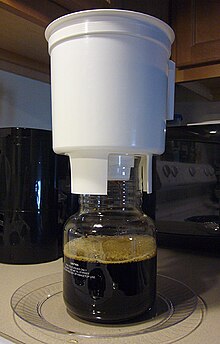Cold brew coffee

Cold brew, or cold water extract, refers to the process of steeping coffee grounds in room temperature or cold water for an extended period. Cold brew coffee is not to be confused with iced coffee, which generally refers to coffee that is brewed hot and then chilled by pouring over or adding ice, though iced coffee can refer to cold brew coffee served on ice.
Process

The cold-water-extract process requires grinding: coarse-ground beans are soaked in water for a prolonged period of time, usually 12 hours or more.[citation needed] The water is normally kept at room temperature, but chilled water can also be used. The grounds must be filtered out of the water after they have been steeped using a paper coffee filter, a fine metal sieve, a French press or felt. The result is a coffee concentrate that is often diluted with water or milk, and can be served hot, over ice, or blended with ice and other ingredients such as chocolate.
Slow-drip cold brew, also known as Kyoto-style, or as Dutch coffee in East Asia,[1] refers to a process in which water is dripped through coffee grounds at room temperature over the course of many hours.[2]
Cold brew tea is a similar process using tea as opposed to coffee.[3]
Purpose
Because the ground coffee does not come into contact with heated water, the process of extracting flavor from the beans produces a chemical profile different from conventional brewing methods.[4] Coffee beans contain a number of constituent parts that are more soluble at high temperatures, such as caffeine, oils and fatty acids. Brewing at a lower temperature results in lower acidity and lower caffeine content.[5][6] However, even though there is less caffeine extracted with the cold brew method, the higher coffee-to-water ratio may compensate for this difference in solubility, resulting in a brew with equal, if not more, caffeine.[7][8]
See also
References
- ^ Hof, Karina (August 13, 2015). "Dutch Coffee: Batavia's Slow-Dripped, Cooled Down Take On A Classic". Sprudge.
- ^ http://tmagazine.blogs.nytimes.com/2010/07/29/ristretto-kyoto-to-stay/?_r=0#
- ^ Peters, A. Brewing Makes the Difference. 14th Colloquium of Association for Science and Information on Coffee. Archived from the original (PDF) on 5 November 2014. Retrieved 5 November 2014.
{{cite conference}}: External link in|conferenceurl=|conferenceurl=ignored (|conference-url=suggested) (help) - ^ Jon Bonné (August 20, 2004). "Coffee, without the heat". TODAY. Retrieved Oct 7, 2015.
- ^ Peter Giuliano. "Why you should stop cold-brewing, and use the Japanese Iced Coffee Method". Pax Coffea. Retrieved Nov 6, 2015.
- ^ "Does Cold Brew Coffee Have More Caffeine than Hot Coffee?". Coffee Chemistry. Retrieved Nov 6, 2015.
- ^ "Does Cold Brew Coffee Have More Caffeine than Hot Coffee?". The Kitchn. July 13, 2015.
- ^ "4 Things You Need to Know About Cold-Brewed Coffee". May 2, 2015.
External links
![]() Media related to cold brew at Wikimedia Commons
Media related to cold brew at Wikimedia Commons
